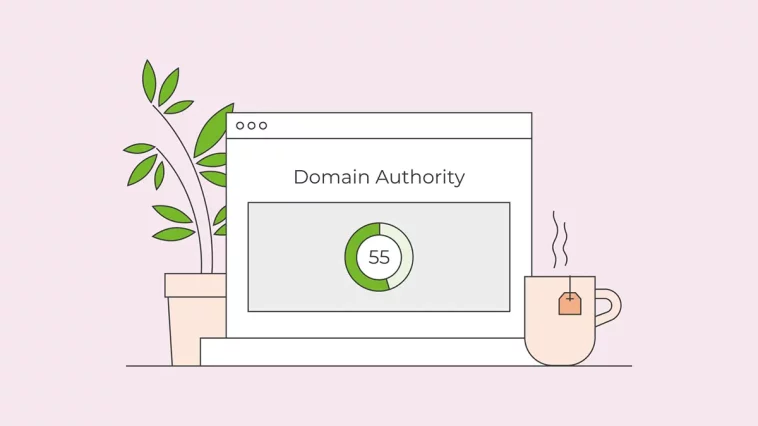In the fiercely competitive digital landscape, achieving high search engine rankings is crucial for online visibility and success. One key metric that significantly influences your website’s standing in search results is Domain Authority (DA). In this article, we’ll explore the importance of DA and effective strategies to increase it, empowering your website to dominate search rankings.
Understanding Domain Authority
Domain Authority, a metric developed by Moz, is a numerical score that ranges from 1 to 100, predicting how well a website is likely to perform in search engine results. The higher the DA, the more authoritative and credible the website is considered by search engines. This score is influenced by various factors, including the quality and quantity of backlinks, content relevance, and overall site structure.
Building Quality Backlinks
One of the fundamental pillars in elevating your website’s Domain Authority (DA) lies in the strategic acquisition of high-quality backlinks. Backlinks, also known as inbound links, are essentially other websites linking to your content. Think of them as digital endorsements – the more reputable websites vouching for yours, the higher your website’s perceived authority in the eyes of search engines.
1. Create Compelling, Shareable Content:
The bedrock of any successful backlink strategy is creating content that not only resonates with your target audience but also compels others in your industry to reference and link back to it. This involves producing informative, engaging, and unique content that stands out in a crowded online space.
2. Actively Engage in Outreach:
Proactively reaching out to influencers, thought leaders, and relevant websites within your industry is a proactive way to secure valuable backlinks. Establish genuine relationships and partnerships, and don’t be afraid to ask for a link when you’ve produced content that aligns with their interests or expertise.
3. Collaborate with Industry Peers:
Collaborative efforts with other businesses or websites in your niche can result in reciprocal backlinks. This mutually beneficial exchange not only broadens your audience but also enhances your website’s credibility. Seek out opportunities for guest posts, co-authored content, or joint projects that naturally integrate backlinks to your site.
4. Leverage Guest Posting Opportunities:
Guest posting remains a powerful method to secure high-quality backlinks. By contributing valuable content to reputable websites within your industry, you not only tap into their audience but also gain a credible link back to your own site. Ensure that your guest posts provide genuine value and align with the host site’s audience and themes.
5. Monitor and Analyze Backlink Quality:
Not all backlinks are created equal. Regularly monitor your backlink profile using tools like Moz or Ahrefs to assess the quality of links pointing to your site. Disavow toxic or spammy links, and focus on cultivating relationships with authoritative websites that contribute positively to your site’s reputation.
In essence, building quality backlinks is an ongoing process that demands a combination of excellent content creation, relationship building, and strategic outreach. By nurturing a diverse and high-quality backlink profile, your website can steadily increase its Domain Authority, leading to improved search engine rankings and, ultimately, greater online visibility.
Optimizing On-Page Content
Optimizing on-page content is a fundamental aspect of improving your website’s Domain Authority (DA) and overall search engine visibility. This process involves fine-tuning various elements within your web pages to ensure they are not only relevant to search engines but also provide a positive user experience. Here’s a detailed breakdown of how you can effectively optimize your on-page content:
1. Conduct Thorough Keyword Research:
Start by conducting comprehensive keyword research to identify the terms and phrases relevant to your content and target audience. Utilize tools such as Google Keyword Planner, SEMrush, or Ahrefs to discover high-performing keywords that align with your website’s theme.
2. Seamlessly Integrate Keywords:
Once you’ve identified your target keywords, integrate them seamlessly into your content. Avoid keyword stuffing, and instead, focus on incorporating keywords naturally within headings, subheadings, body text, and meta descriptions. This not only signals to search engines the relevance of your content but also enhances the readability for users.
3. Develop Pillar Pages and Topic Clusters:
Organize your content in a strategic manner by creating pillar pages and topic clusters. Pillar pages serve as comprehensive guides on a central topic, while topic clusters consist of related subtopics that link back to the pillar page. This interlinked structure not only helps search engines understand the hierarchy of your content but also strengthens the overall authority of your website.
4. Prioritize User-Friendly Site Structure:
Optimize the structure of your website for a seamless user experience. Ensure that your site navigation is intuitive and logical, making it easy for visitors to find relevant information. A well-organized site structure not only improves user satisfaction but also assists search engines in crawling and indexing your pages efficiently.
5. Optimize Meta Tags:
Craft compelling and descriptive meta titles and meta descriptions for each page. These tags serve as the first point of interaction between users and your content in search engine results. Include relevant keywords, but focus on creating concise, engaging descriptions that encourage users to click through to your site.
6. Use Descriptive and Engaging Headings:
Break up your content with descriptive and engaging headings. Utilize H1, H2, and H3 tags to create a hierarchical structure that communicates the main points of your content. Clear headings not only enhance readability but also provide search engines with valuable information about the structure and topics covered in your content.
7. Optimize Images and Multimedia:
Optimize images by using descriptive file names and alt text. This not only improves accessibility for users with disabilities but also provides additional context to search engines. Compress images to ensure faster page loading times, contributing to a positive user experience.
8. Regularly Update and Refresh Content:
Regularly update and refresh your content to ensure it remains relevant and valuable over time. Search engines favor fresh and up-to-date content, and this practice signals to them that your website is actively maintained and provides current information.
9. Implement Schema Markup:
Consider implementing schema markup to provide search engines with additional context about the content on your pages. This can enhance the appearance of your search results with rich snippets, making your listings more appealing to users.
10. Monitor and Analyze Performance:
Utilize analytics tools to monitor the performance of your on-page content. Track key metrics such as bounce rate, time on page, and conversion rates to identify areas for improvement. Analyzing user behavior helps you refine your content strategy and enhance the overall quality of your pages.
By focusing on these on-page optimization strategies, you not only contribute to the improvement of your website’s Domain Authority but also create a user-friendly and authoritative digital presence. This holistic approach to content optimization aligns with the evolving landscape of search engine algorithms and user expectations, setting the stage for sustained online success.
Prioritizing Technical SEO
Technical SEO is the backbone of a well-optimized website, laying the foundation for improved search engine rankings and enhanced user experience. This facet of SEO involves addressing technical aspects that impact how search engines crawl, index, and rank your site. Here’s a comprehensive breakdown of how to prioritize technical SEO for optimal results:
1. Conduct Regular Site Audits:
Initiate your technical SEO strategy with regular site audits. Tools such as Google Search Console, SEMrush, or Screaming Frog can help identify issues like broken links, duplicate content, and crawl errors. Addressing these issues ensures that search engine crawlers can navigate your site seamlessly.
2. Optimize Site Speed:
Page loading speed is a critical factor for both user experience and search engine rankings. Compress images, leverage browser caching, and minimize unnecessary scripts to improve load times. Fast-loading pages not only enhance user satisfaction but also contribute positively to your website’s search engine performance.
3. Ensure Mobile Responsiveness:
With the increasing prevalence of mobile users, it’s imperative that your website is mobile-friendly. Google prioritizes mobile-first indexing, meaning it assesses the mobile version of your site for ranking purposes. Ensure responsive design, easy navigation, and optimized content for users on various devices.
4. Implement Proper Redirects:
Use 301 redirects for permanent URL changes and 302 redirects for temporary changes. This ensures that both users and search engines are directed to the correct pages. Broken or improper redirects can negatively impact user experience and harm your site’s SEO.
5. Optimize URL Structure:
Craft clean, descriptive, and user-friendly URLs. Avoid lengthy strings of numbers or irrelevant characters. A well-structured URL not only aids search engines in understanding the content but also enhances the user’s ability to comprehend the page’s context.
6. Create an XML Sitemap:
Generate and submit an XML sitemap to search engines. This file provides a roadmap of your website’s structure, helping search engines index your pages more efficiently. Regularly update and submit the sitemap to reflect any changes or new additions to your site.
7. Enhance Website Security:
Secure your website with HTTPS, encrypting data between the user’s browser and your server. Google considers HTTPS as a ranking factor, and users are more likely to trust a secure site. Regularly update your security protocols and plugins to safeguard against potential threats.
8. Improve Site Navigation:
Streamline your website’s navigation for both users and search engines. A clear and intuitive navigation structure makes it easier for visitors to find relevant information and helps search engines understand the hierarchy and relationships between different pages.
9. Canonicalization:
Address duplicate content issues by implementing canonical tags. These tags signal to search engines which version of a page is the preferred, consolidating ranking signals and preventing dilution of SEO authority.
10. Monitor and Manage Crawl Budget:
Understand how search engine crawlers allocate resources on your site by monitoring crawl budget. Ensure that important pages are prioritized for crawling, and use tools like Google Search Console to identify and address crawl errors.
11. Schema Markup Implementation:
Utilize schema markup to provide additional context to search engines about your content. This can result in rich snippets in search results, improving visibility and click-through rates.
12. Monitor Site Performance:
Regularly monitor your site’s performance metrics, including page load times, server response times, and overall user experience. Address any issues promptly to maintain a positive user experience and satisfy search engine algorithms.
By prioritizing technical SEO, you not only create a more search engine-friendly website but also enhance the overall user experience. A technically sound website serves as a strong foundation for successful SEO efforts, contributing to higher search rankings, increased visibility, and sustained online success.
Consistent Content Creation
Consistent content creation is a cornerstone of successful digital marketing strategies, playing a pivotal role in enhancing your website’s Domain Authority (DA) and search engine rankings. This ongoing effort involves regularly producing and publishing high-quality, relevant content that aligns with your audience’s interests and industry trends. Here’s a detailed breakdown of how consistent content creation contributes to your website’s success:
1. Develop a Content Calendar:
Start by creating a content calendar that outlines your publishing schedule and content themes. This strategic approach helps you plan ahead, ensuring a steady flow of content that addresses your audience’s needs and aligns with your overall marketing objectives.
2. Identify Target Keywords:
Before creating content, conduct keyword research to identify terms and phrases relevant to your industry. Incorporate these keywords naturally into your content to enhance its search engine visibility and increase the likelihood of ranking for specific queries.
3. Diversify Content Types:
Offer a variety of content types to cater to different preferences within your audience. This can include blog posts, articles, infographics, videos, podcasts, and more. Diversifying your content portfolio not only keeps your audience engaged but also broadens your reach across various online platforms.
4. Provide Value and Solve Problems:
Create content that provides genuine value to your audience. Address their pain points, answer their questions, and offer solutions to their problems. Valuable content not only establishes your authority in your niche but also encourages repeat visits and social sharing.
5. Maintain Consistent Brand Voice:
Develop and maintain a consistent brand voice across all your content. Whether your tone is informative, conversational, or authoritative, ensuring consistency helps build brand recognition and fosters a sense of trust among your audience.
6. Stay Updated with Industry Trends:
Keep a finger on the pulse of industry trends and news. Creating content that reflects current trends not only demonstrates your industry knowledge but also positions your website as a go-to source for up-to-date information.
7. Encourage Audience Engagement:
Foster engagement with your audience by encouraging comments, social shares, and discussions around your content. Respond to comments promptly and actively participate in conversations on social media. Engaged audiences are more likely to become loyal followers and advocates for your brand.
8. Leverage Social Media Channels:
Share your content across relevant social media channels. Craft engaging social media posts that entice users to click through to your website. Social signals, such as likes, shares, and comments, can positively impact your website’s search engine performance.
9. Optimize for SEO:
While creating content, pay attention to on-page SEO elements. Optimize titles, meta descriptions, and headings with relevant keywords. This not only improves your content’s visibility in search engine results but also contributes to the overall SEO health of your website.
10. Analyze Performance Metrics:
Regularly monitor and analyze the performance of your content using analytics tools. Track metrics such as page views, time on page, bounce rate, and social shares to gain insights into what resonates with your audience. Use this data to refine your content strategy over time.
11. Experiment with New Ideas:
Don’t be afraid to experiment with new content ideas and formats. Whether it’s a series of in-depth guides, interactive content, or user-generated content campaigns, embracing innovation can help your website stand out in a crowded digital landscape.
12. Repurpose and Update Existing Content:
Extend the lifespan of your content by repurposing it into different formats or updating it with fresh information. This not only maximizes the value of your existing content but also signals to search engines that your website is consistently providing relevant and updated information.
By consistently creating valuable and relevant content, you not only engage your audience but also signal to search engines that your website is a dynamic and authoritative source. Over time, this commitment to content creation contributes to improved Domain Authority, higher search engine rankings, and sustained digital success.
Conclusion
In the ever-evolving landscape of online visibility, mastering the art of increasing Domain Authority is essential for dominating search rankings. By building quality backlinks, optimizing on-page content, prioritizing technical SEO, and consistently creating valuable content, your website can ascend to new heights of authority in the digital realm. As your Domain Authority strengthens, so too will your position in search engine results, driving organic traffic and establishing your website as a formidable force in your industry.



Comments